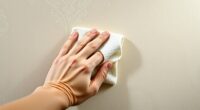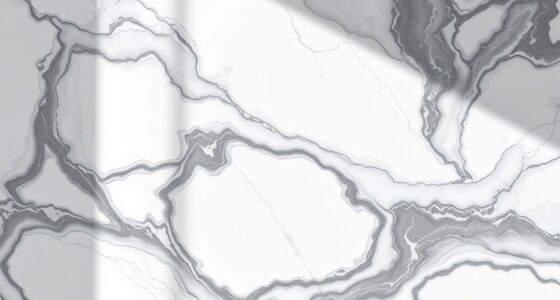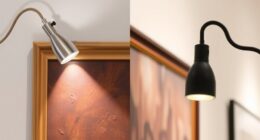To keep your wallpaper safe near heat and moisture, choose heat-resistant, moisture-proof materials and apply protective coatings or sealants. Install the wallpaper correctly in moist areas using suitable adhesives, and ensure the surface is prepared properly. Maintain good ventilation with vents and exhaust fans to control humidity, and keep heat sources well away from wallpaper. Regularly inspect and maintain the area to prevent damage or safety hazards, and discover more tips to protect your space effectively.
Key Takeaways
- Choose heat-resistant, fire-retardant wallpaper materials suited for high-temperature areas.
- Use moisture-resistant adhesives and sealants to prevent water damage and mold growth.
- Ensure proper surface preparation and installation to enhance durability against heat and humidity.
- Maintain adequate ventilation with vents and exhaust fans to control humidity and reduce moisture buildup.
- Keep heat sources and electrical devices away from wallpaper, and perform regular inspections for safety and damage.
Choosing Heat-Resistant Wallpaper Materials
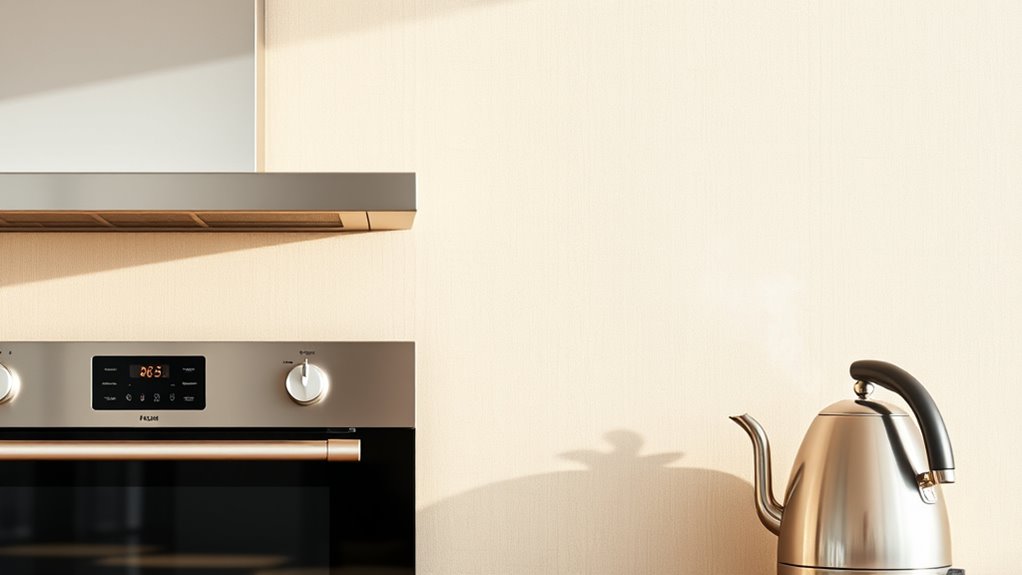
When selecting wallpaper for areas near heat sources or moisture, it’s essential to choose materials that can withstand higher temperatures without warping or peeling. Look for wallpapers made with fire resistant coatings, which help prevent ignition and limit fire spread. Additionally, opt for heatproof fabrics or textiles that resist damage from heat exposure. These materials are specially treated to endure temperature fluctuations, ensuring safety and durability. Understanding material properties can further help in choosing the most suitable wallpaper for such settings. Choosing wallpapers with fire-resistant coatings adds an extra layer of protection, especially in environments prone to heat exposure. Avoid standard wallpapers that may soften, peel, or pose fire hazards in high-heat environments. Incorporating heatproof fabrics can enhance the overall safety of your space by reducing the risk of damage and fire. Moreover, selecting proper installation techniques can prevent issues like peeling or warping over time, enhancing both safety and appearance. By prioritizing fire resistant coatings and heatproof fabrics, you create a safer space where wallpaper remains intact and resistant to damage, reducing fire risks and maintaining the room’s aesthetic appeal. Proper selection is the first step toward a safe, heat-resistant environment.
Proper Installation Techniques in Moisture-Prone Areas
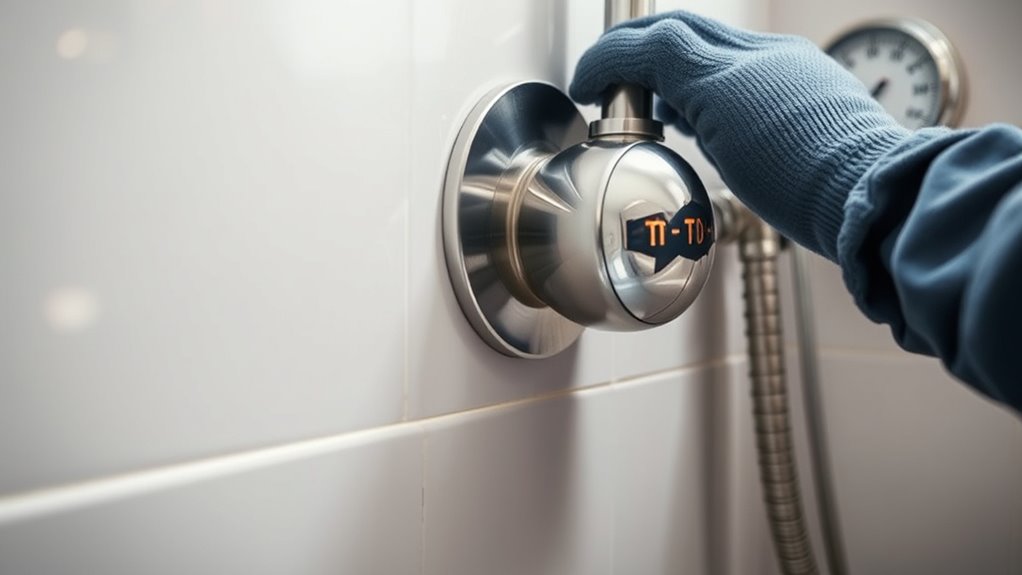
Before installing wallpaper in moisture-prone areas, make sure the surface is clean, smooth, and dry. Use adhesives specifically designed to resist moisture to guarantee a secure, long-lasting bond. Proper surface prep and the right adhesives are essential for safety and durability in these challenging spaces. Additionally, understanding data privacy challenges can help ensure that any digital tools used during installation adhere to proper security standards. Awareness of product safety considerations can further prevent issues related to heat and moisture exposure, ensuring the wallpaper remains secure over time. Incorporating predictive analytics can also assist in selecting the best materials for specific conditions, reducing the risk of future damage.
Surface Preparation Essentials
Proper surface preparation is essential to guarantee your wallpaper adheres securely in moisture-prone areas. Begin by removing any existing wallpaper carefully through wallpaper removal techniques to create a clean surface. Inspect the wall for damage or mold, and repair any issues before proceeding. Next, thoroughly clean the wall to eliminate dust, grease, or residue that could interfere with adhesion. Once clean, apply a suitable surface primer designed for high-humidity environments. Surface priming creates a uniform base, improves adhesion, and helps prevent moisture from seeping through. Moisture control is crucial in ensuring the longevity of your wallpaper in such conditions, as inadequate management can lead to peeling or mold growth. Additionally, understanding intelligence and espionage can help identify covert methods used to monitor moisture levels or detect hidden vulnerabilities in building structures. Recognizing moisture mitigation strategies can further enhance the durability of your wallpaper installation in challenging environments. Taking the time to prepare your surface properly ensures a smooth, durable finish that stays securely in place despite the challenges posed by heat and moisture.
Moisture-Resistant Adhesives
Using the right adhesives is key to guaranteeing your wallpaper stays put in moist environments. Moisture resistant adhesives create a strong bond that withstands humidity and prevent peeling or bubbling. When selecting adhesives, look for products labeled specifically for moisture-prone areas, as they enhance wallpaper durability over time. Proper application is essential—spread the adhesive evenly and follow the manufacturer’s instructions closely. This minimizes gaps and air pockets that could trap moisture. Avoid general-purpose adhesives, which may break down or lose their grip in humid conditions. Additionally, choosing adhesives with long-lasting properties ensures the durability of your wallpaper in challenging environments. Ensuring your wallpaper has moisture-resistant backing further boosts its resilience against humidity. By choosing the correct moisture-resistant adhesives and applying them properly, you markedly improve your wallpaper’s longevity and safety near heat and moisture. This guarantees your decorative wall stays beautiful and secure for years to come.
Ventilation Strategies to Minimize Humidity

Ensuring proper ventilation is key to reducing humidity and protecting your wallpaper. You should focus on maintaining adequate airflow, installing exhaust fans where needed, and placing vents strategically. These steps help keep moisture levels in check and prevent damage. Additionally, avoiding the placement of heat-emitting devices near wallpaper can further minimize risks, as excessive heat can accelerate deterioration. Proper ventilation strategies and avoiding direct contact with walls can also help maintain a stable environment, which is essential for preserving wallpaper over time. Incorporating humidistat controls can further assist in maintaining optimal humidity levels and safeguarding your walls.
Adequate Airflow Circulation
To prevent wallpaper damage near heat and moisture, maintaining adequate airflow is vital. Proper airflow regulation ensures moisture doesn’t linger, reducing the risk of mold and peeling. Ventilation enhancement involves strategic placement of vents and open windows to promote air movement. You can optimize airflow by using fans or adjusting existing vents to increase circulation. Consider this airflow management approach:
| Strategy | Benefit | Implementation Tips |
|---|---|---|
| Cross Ventilation | Improves overall airflow | Open windows on opposite sides |
| Ceiling Fans | Circulates air evenly | Use in rooms with high humidity |
| Vent Placement | Targets specific moisture hotspots | Install near heat sources and damp areas |
| Airflow Regulation | Maintains consistent circulation | Adjust fan speeds as needed |
| Ventilation Enhancement | Reduces humidity buildup | Add vents or upgrade existing systems |
Additionally, ensuring proper air exchange helps keep humidity levels in check and protects wallpaper from damage. Proper air quality monitoring can further assist in maintaining optimal conditions for wallpaper preservation. Regularly checking humidity levels ensures that moisture remains within safe limits to prevent deterioration. Moreover, incorporating dehumidifiers can effectively reduce excess moisture in particularly humid environments.
Use of Exhaust Fans
Exhaust fans are an effective way to reduce humidity levels and protect your wallpaper from moisture damage. Their effectiveness depends on proper installation and consistent use. When functioning correctly, exhaust fans help vent moist air outside, preventing water vapor from accumulating and seeping into your wallpaper. To guarantee maximum exhaust fan effectiveness, you should regularly perform ventilation system maintenance, such as cleaning filters and checking for obstructions. Properly maintained exhaust fans work quietly and efficiently, maintaining a dry environment that preserves your wallpaper’s integrity. Installing exhaust fans in high-moisture areas like bathrooms and kitchens is especially important. Additionally, understanding proper ventilation strategies can further enhance moisture control in your space. Regularly monitoring indoor humidity levels and using moisture control tools can also contribute significantly to protecting your wallpaper from damage. Incorporating humidity management techniques can help create an optimal environment for your wallpaper’s longevity. Maintaining optimal ventilation practices ensures the continuous protection of your wallpaper against moisture-related issues.
Proper Vent Placement
Proper vent placement plays an essential role in controlling humidity levels and protecting your wallpaper from moisture damage. Properly positioned vents ensure effective airflow optimization, reducing moisture buildup that can weaken wallpaper adhesion. To visualize, consider the following placement strategies:
| Vent Location | Purpose | Ideal Position |
|---|---|---|
| Near the ceiling | Remove rising warm, moist air | Opposite windows or corners |
| Near the floor | Extract cooler, moist air | Close to bathrooms or kitchens |
| Opposite each other | Enhance cross-ventilation | On opposite walls |
| High and low vents | Maximize airflow | For rooms with high humidity |
| Avoid obstructions | Maintain airflow | Keep vents unobstructed |
Optimizing vent placement guarantees consistent airflow, minimizing humidity and safeguarding your wallpaper’s longevity.
Using Sealants and Protective Coatings for Safety

Using sealants and protective coatings is an effective way to enhance safety when installing wallpaper near heat and moisture sources. Sealant application creates a barrier that prevents water vapor and heat from penetrating the wallpaper, reducing the risk of damage and mold growth. Protective coatings add an extra layer of defense, helping to withstand temperature fluctuations and humidity. When applying sealants, choose products compatible with your wallpaper and follow the manufacturer’s instructions carefully. Proper sealant application ensures a tight seal, minimizing exposure to moisture and heat that could compromise the wallpaper’s integrity. Using quality protective coatings further enhances durability, making your wallpaper safer and longer-lasting in challenging environments. This proactive approach helps maintain a safe, healthy space while preserving your wallpaper’s appearance.
Maintaining Safe Distances From Heat Sources
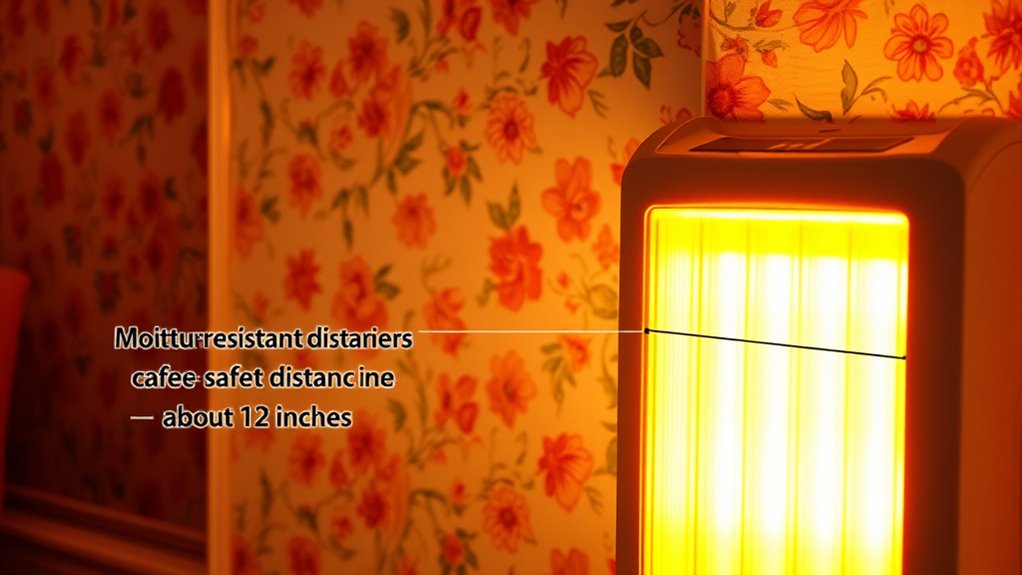
To prevent fire hazards and damage, it’s essential to maintain a safe distance between wallpaper and heat sources. Keep heaters, radiators, and candles away from wallpaper to reduce the risk of ignition. When installing electrical outlets or switches, ensure they are placed thoughtfully, following electrical safety tips to avoid overheating. Use heat-resistant materials or barriers if wiring runs near wallpaper. Avoid running cords or extension cords across wallpapered surfaces, as they can generate heat or cause damage. Regularly check appliances and wiring for signs of wear or overheating. Maintaining proper clearance around heat sources not only helps with fire hazard prevention but also prolongs the life of your wallpaper. Always prioritize safety by keeping heat-generating devices well away from your walls.
Regular Inspection and Upkeep of Wallpaper Areas
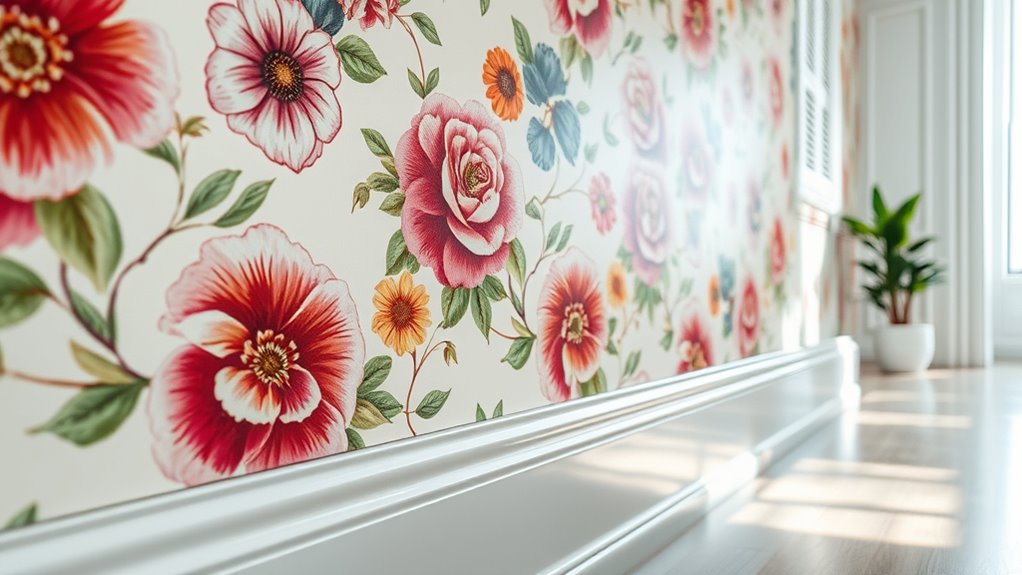
Regular inspections of your wallpaper are essential to catch issues early and prevent costly damage. By routinely checking for peeling, bubbling, or discoloration, you help maintain its durability and appearance. Addressing minor problems promptly preserves the aesthetic considerations of your space and extends wallpaper lifespan. Use the table below to guide your upkeep routine:
| Inspection Task | Frequency |
|---|---|
| Check for peeling or bubbling | Monthly |
| Examine for discoloration | Bi-monthly |
| Ensure edges are secure | Every 3 months |
| Look for signs of moisture | Weekly, especially near heat sources |
Consistent upkeep keeps your wallpaper looking fresh and resilient against environmental factors, ensuring a safe, beautiful environment.
Safe Cleaning Practices for Wallpaper Near Heat and Moisture

Maintaining your wallpaper’s appearance near heat and moisture requires careful cleaning practices to prevent damage. Use mild, non-abrasive cleaners and avoid excessive moisture, which can compromise wallpaper durability. Always test cleaning solutions on a small, inconspicuous area first to check for adverse reactions. When wiping, use a soft cloth or sponge and gently clean the surface, avoiding scrubbing that could lift or tear the paper. Steer clear of harsh chemicals or solvents that might weaken adhesives or cause discoloration. Regular but gentle cleaning helps preserve the aesthetic considerations of your wallpaper, keeping it looking fresh without risking peeling or warping. Remember, the key is to balance cleanliness with protection to extend your wallpaper’s lifespan near heat and moisture sources.
Frequently Asked Questions
How Can I Tell if My Wallpaper Is Suitable for High-Heat Areas?
You can tell if your wallpaper is suitable for high-heat areas by checking its label or product description for heat-resistant coatings. Look for wallpapers that specify they’re designed for kitchens or bathrooms, as they often include moisture barriers and heat resistance. If unsure, consult the manufacturer or a professional. Using heat-resistant coatings and moisture barriers can help protect your wallpaper from heat and humidity, ensuring durability.
Are There Specific Safety Regulations for Wallpaper in Moisture-Prone Environments?
You definitely want to follow strict safety regulations when using wallpaper in moisture-prone environments. Look for wallpapers with fire-resistant coatings and moisture barriers, which are designed for such conditions. These features are vital in preventing fires and water damage. Always check local building codes and manufacturer instructions to guarantee compliance. Ignoring these guidelines can lead to serious safety hazards, so prioritize products and practices that keep your space safe and secure.
What Are the Signs of Damage Caused by Heat or Moisture on Wallpaper?
You’ll notice signs of damage caused by heat or moisture on your wallpaper, such as water damage, which appears as discoloration or staining, and peeling wallpaper, especially along edges or seams. Warping and bubbling are common indicators, signaling that moisture has gotten behind the paper. If you see these signs, it’s important to address the issue quickly to prevent further damage and maintain your wall’s appearance.
Can Certain Cleaning Products Damage Heat-Resistant or Moisture-Resistant Wallpaper?
Like a knight with his trusty sword, you need to choose cleaning products carefully. Certain cleaning products can damage heat-resistant or moisture-resistant wallpaper if they aren’t compatible with the wallpaper material considerations. Always check the cleaning product compatibility before use, as harsh chemicals or abrasives might weaken or stain your wallpaper. By selecting gentle cleaners suited for your wallpaper type, you protect its durability and appearance.
How Often Should I Inspect Wallpaper Near Heat Sources for Safety?
You should inspect wallpaper near heat sources at least once every three to six months. During your safety checktips, look for signs of bubbling, peeling, or discoloration, which could indicate heat or moisture damage. Regular inspections help you catch issues early, preventing potential safety hazards. Always turn off heat sources before inspecting, and consider adding protective barriers if you notice any damage or if the wallpaper is in a high-risk area.
Conclusion
To keep your wallpaper safe near heat and moisture, follow these tips diligently. Choose heat-resistant materials, install them properly, and ensure good ventilation. Use sealants and maintain safe distances from heat sources, inspecting regularly for damage. Remember, an ounce of prevention is worth a pound of cure—staying vigilant now avoids costly repairs later. By taking these precautions, you’ll enjoy beautiful, durable wallpaper that stands the test of time and environmental challenges.

